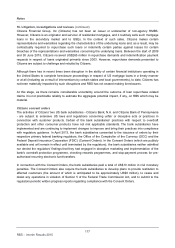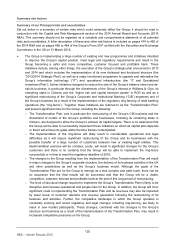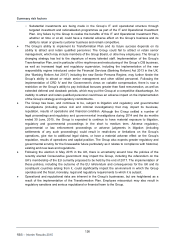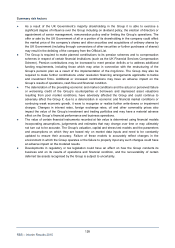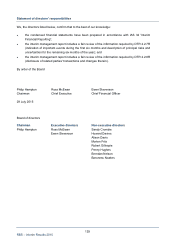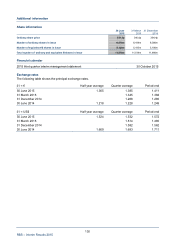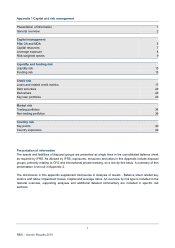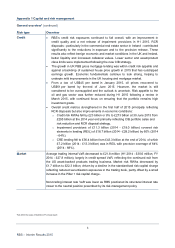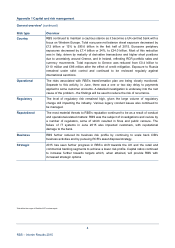RBS 2014 Annual Report Download - page 129
Download and view the complete annual report
Please find page 129 of the 2014 RBS annual report below. You can navigate through the pages in the report by either clicking on the pages listed below, or by using the keyword search tool below to find specific information within the annual report.
127
RBS – Interim Results 2015
Summary risk factors
● Despite the improved outlook for the global and UK economy over the near to medium-term, actual o
r
perceived difficult global economic conditions, potential volatility in the UK housing market as well as
increased competition, particularly in the UK, may create challenging economic and market conditions
and a difficult operating environment for the Group’s businesses, as it continues to refocus its
operations on the UK. These factors, together with continuing uncertainty relating to the recovery o
f
the Eurozone economy and volatile financial markets, in part due to the monetary and fiscal policies
and measures carried out by central banks, the continued prolonged periods of low interest rates, the
impact of any Greek sovereign default or exit from the Eurozone and slowing growth in China, have
adversely affected and may continue to adversely affect the Group’s businesses, earnings, financial
condition and prospects.
● The Group’s business performance, financial condition and capital and liquidity ratios could be
adversely affected if its capital is not managed effectively or as a result of increasingly stringent
regulatory requirements relating to capital adequacy, including those arising out of the implementation
of Basel III or future proposals and the uncertainty arising from the consistent implementation of such
rules in the various jurisdictions in which the Group operates. Maintaining adequate capital resources
and meeting the requisite capital adequacy requirements may prove increasingly difficult and costl
y
and will depend on the Group’s continued access to funding sources, including following the
implementation of the ring-fence, as well as the effective management of its balance sheet and capital
resources.
● The Group’s ability to meet its obligations including its funding commitments depends on the Group’s
ability to access sources of liquidity and funding. The inability to access liquidity and funding due to
market conditions or otherwise or to do so at a reasonable cost, could adversely affect the Group’s
financial condition and results of operations. Furthermore, the Group’s borrowing costs and its access
to the debt capital markets and other sources of liquidity depend significantly on its and, to a lesse
r
extent the UK’s credit ratings.
● The Group is subject to substantial regulation and oversight and although it is difficult to predict with
certainty the effect that the recent regulatory changes, developments and heightened levels of public
and regulatory scrutiny will have on the Group, the enactment of legislation and regulations in the UK,
the EU and the US has resulted in increased capital, funding and liquidity requirements, changes in
the competitive landscape, changes in other regulatory requirements and increased operating costs
and has impacted, and will continue to impact, product offerings and business models as well as the
risks that the Group may be subject to an increased number of regulatory investigations and legal
proceedings and may be unable to comply with such requirements in the manner or within the
timeframes required. A number of reviews and investigations are currently ongoing in the UK and
other jurisdictions in which the Group operates which may result in further legislative changes.
● The Group or any of its UK bank subsidiaries may face the risk of full nationalisation or othe
r
resolution procedures, including recapitalisation of the Group or any of its UK bank subsidiaries,
through the exercise of the bail-in tool which was introduced in the UK by the Banking Reform Act
2013 and implemented in line with the provisions of the Bank Recovery and Resolution Directive. In
the event of the failure of the Group, various actions could be taken by or on behalf of the U
K
Government, including actions in relation to any securities issued, new or existing contractual
arrangements and transfers of part or all of the Group’s businesses.
● The Group is highly dependent on its IT systems, which are currently subject to a significant
investment and rationalisation programme. The Group has been and expects to continue to be subjec
t
to cyber-attacks which expose the Group to loss of customer data or other sensitive information and
which, combined with other failures of the Group’s information technology systems, may hinder its
ability to service its customers which could result in long-term damage to the Group’s reputation,
businesses and brands.


